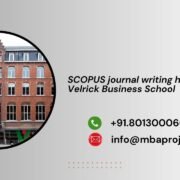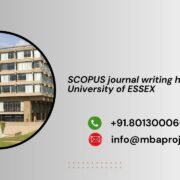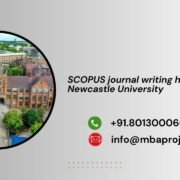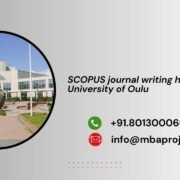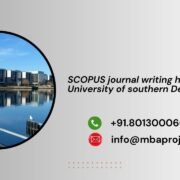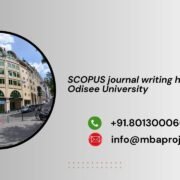SCOPUS journal writing help in Velrick Business School
SCOPUS journal writing help in Velrick Business School
SCOPUS journal writing help in Velrick Business School. Publishing in SCOPUS-indexed journals is an essential milestone for researchers, doctoral candidates, and faculty members at Vlerick Business School. A SCOPUS publication enhances global visibility, boosts academic credentials, and strengthens professional opportunities. Our specialized SCOPUS journal writing help in Vlerick Business School offers comprehensive guidance to ensure your research meets the highest international standards and stands out in competitive academic circles.
Why SCOPUS Publication Matters for Vlerick Researchers
SCOPUS is the world’s most trusted abstract and citation database, recognized for its rigorous evaluation and high-quality indexing. Publishing in a SCOPUS journal guarantees international recognition, increased citation rates, and a strong research profile—critical advantages for scholars and professionals in business and management.
Key Benefits of SCOPUS Indexing
-
Global Visibility: Your research is accessible to universities, corporations, and policymakers worldwide.
-
Academic Career Growth: Supports tenure applications, research grants, and global teaching opportunities.
-
Research Impact: Ensures higher citation scores and measurable academic influence.
Expert SCOPUS Journal Writing Services for Vlerick Business School
Our tailored services are designed to meet the unique needs of Vlerick Business School researchers in disciplines such as business administration, strategy, finance, entrepreneurship, innovation, and digital transformation.
Complete Research Support
We guide you through every stage of the publication process:
-
Selecting a novel research topic aligned with emerging trends in management and business strategy.
-
Designing a robust methodology with clear objectives and measurable outcomes.
-
Integrating recent and relevant literature to highlight originality and significance.
Comprehensive Literature Review
A well-developed literature review strengthens your paper’s academic foundation. Our team ensures:
-
Thorough database searches in SCOPUS and Web of Science.
-
Critical analysis of existing studies to identify research gaps.
-
Incorporation of current, high-impact references to enhance credibility.
Structured Manuscript Development
SCOPUS journals require precise formatting and organization. We provide:
-
Abstracts optimized with strategic keywords for better discoverability.
-
A compelling introduction that defines context, purpose, and contribution.
-
Methodology sections detailing research design, sampling, and analysis.
-
Results and discussion showcasing clear interpretations and actionable insights.
-
References and citations formatted according to journal guidelines such as APA, Harvard, or Chicago.
Language Polishing and Technical Editing
Our editing team ensures your manuscript is publication-ready:
-
Grammar and syntax refinement by native English editors.
-
Advanced plagiarism checks to guarantee originality and compliance.
-
Formatting adjustments to maintain consistency across tables, figures, and appendices.
Target Journal Selection and Submission Strategy
Selecting the right journal is key to successful publication. We assist with:
-
Identifying high-impact SCOPUS journals that align with your research area.
-
Evaluating impact factors, acceptance rates, and editorial scope.
-
Preparing a professional cover letter and supporting documents to strengthen submission.
Handling Peer Review and Revisions
Our support continues beyond initial submission:
-
Crafting detailed responses to reviewer comments.
-
Providing additional data analysis or references when required.
-
Ensuring prompt resubmission to meet journal deadlines.
Specialized Research Areas for Vlerick Scholars
Vlerick Business School researchers are known for cutting-edge work in business and innovation. We provide SCOPUS journal writing help in areas such as:
-
Global Business Strategy and Competitive Advantage
-
Entrepreneurship and Venture Capital
-
Digital Transformation and Innovation Management
-
Sustainable Finance and Corporate Governance
-
Cross-Cultural Leadership and International Marketing
Why Choose Our SCOPUS Writing Help for Vlerick Business School
Our services combine academic expertise with professional precision:
-
Experienced Academic Writers with successful SCOPUS publications.
-
Customized Assistance tailored to the standards and expectations of Vlerick Business School.
-
Confidentiality and Timely Delivery to protect your intellectual property and meet deadlines.
Achieve Global Impact with SCOPUS Publication
With our SCOPUS journal writing help in Vlerick Business School, your research can reach a worldwide audience and make a lasting contribution to the field of business and management. From conceptualization to peer-review responses, our expert team ensures that your work meets the highest academic standards.
Publishing in a SCOPUS-indexed journal not only enhances your academic portfolio but also opens doors to global collaborations and career advancement. With our dedicated support, you can focus on innovative research while we handle the complexities of writing, formatting, and submission.
Thank you for reading our Blog “SCOPUS journal writing help in Velrick Business School”.
Also, read our more BLOG here.
For Order “SCOPUS journal ” feel free to contact us at Mob: Call / WhatsApp: +91.8013000664 || Email: info@mbaprojects.net.in





